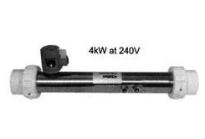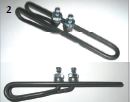Hot Tub Heater Elements
Hot tub heater elements can become inefficient over time as calcium deposits collect on it. In the flow-through electric hot tub heater design, water passes over a heater element inside the tube or manifold. The hot tub electronics signal the heater when to provide power to the heater element to heat the water and also when temperature has been reached.
There are basically two types of temperature sensor mounting in a hot tub which signals the temperature of the water to the electronics which can turn the heater on or off by a relay on a circuit board. One type of temperature sensor mounting is in a thermowell in the spa which measures the hot tub water temperature and passes the information to a pressure switch that makes sure there is enough water in the heater manifold so there is no safety issue. The pressure switch then allows the electronics to pass the voltage to the heater which remains on until the sensors signal that water temperature has been reached.
The other type of heater sensor fits right in a newer style heater manifold, so both heater element and temperature sensors are located in the heater tube. For this type of installation, there is no pressure switch as that safety function is handled by the electronics.
 When replacing a complete heater assembly, it is necessary to know if your system uses a pressure switch mounted to the heater or if it has the sensors inside the heater and does not use a pressure switch.
When replacing a complete heater assembly, it is necessary to know if your system uses a pressure switch mounted to the heater or if it has the sensors inside the heater and does not use a pressure switch.
When replacing just the heater element on a heater that uses a pressure switch, it is a good idea to order a new pressure switch and replace it at the same time to start fresh, as the same problems such as calcium deposits on the heater manifold may also be present in the pressure switch.
How To Tell If A Heater Element Is Bad
Hot tub flow-through heater tubes use a heater element that is basically a resistor. Current passes through the heater which produces heat. The hot element is in touch with the water flowing through the heater manifold or tube and continues to heat the water until the sensors detect that the set temperature has been reached. Problems with the heater element can include a short circuit if the element touches the outside of the manifold or there is a short in the wiring or at the terminals, or an open circuit caused by a broken heating coil. If there was a complete failure of the heater element because the sensors or pressure switch failed and there was air in the heater tube, then more severe damage may have occured.
Most problems with heater elements are related to low or not enough heat. This can be because the element is very old and has a buildup of calcium and other items on the actual element making it more difficult to heat the water. This type of problem also means the spa is running less efficiently and heating bills will go up until the bad heater element is replaced.
If the problem with the heater is a short circuit, then there may be water inside the heater manifold sheath which conducts electricity between the heater coil and the water. This will cause the GFCI to trip, protecting the occupants of the spa, but not allowing the unit to heat. To test the heater element, use an ohm meter to measure the resistance between the two heater terminals. Low ohm readings indicate a short circuit and very high ohm readings indicate an open circuit. You can also test for short to ground by measuring between each heater terminal and the heater element sheath. There should not be any continuity between the sheath and the terminal, or you have a short circuit condition.
The resistance value of the measurement between the 2 heater terminals should vary depending on the kw rating of the heater, but is usually around 10-15 ohms or so. This type of test just helps you determine if there is a short or serious issue and if so, then replace the heater element or the entire flow-through heater. It is recommended to just replace the entire heater if it is over 3-4 years old depending on spa use and how well the water was maintained during that time.
How To Replace A Hot Tub Heater Element
n.B.: Repairs on hot tub equipment and any electrical equipment should only be attempted by qualified individuals as there is an inherent danger when working with electricity and water in the same environment. These tips are provided for informational purposes only. Perform any repairs at your own risk or hire a qualified service technician.
To replace a hot tub heater element, turn off the spa completely and turn the breaker off. Then drain the spa or shut off the service valves on either side of the heater. Remove the spa heater by unscrewing both heater unions taking care not to loose the o-ring inside each of the unions. The o-ring provides the water seal at those points. The heater unions may be removable by hand, or by using large pliers or channel locks. Be careful when using pliers not to crack the heater unions on either side of the heater. You will need to disconnect the 2 lead wires that are connected to the 2 heater lug nuts and note their connections when replacing them on the new heater or heater element. Once the heater manifold is disconnected, remove the heater assembly from the spa and loosen the 2 lug nuts to get the old heater element to drop inside the tube for removal.
To replace heater element, undo top 2 nuts holding the heater element to the heater manifold tube. Take out old element. Be careful not to bend posts on the new heater element. Insert it into tube and put the 2 posts back through the holes in the heater manifold. You do need a 1/4 inch wrench when you tighten nut down to post when you tighten it with the wire. This type of universal heater may have a pressure switch mounted on it, so you would also replace the pressure switch when changing out the element in that type of heater.
Note in this video, it may be better to use 2 seperate wrenches when opening and tightening the nuts on the heater terminals to avoid one of them spinning around endlessly or cracking the sensitive epoxy seal.
There are various types of hot tub heater elements including bowtie heater elements or npt or in-line 120volt or 230volt elements. Some elements can be operated at either 120v or 230 volts, where the wattage is higher when operated at 230v.
Heater Element Cost
Replacement spa heater elements typically are less than half the price of a complete heater.
In the U.S.? Contact us for the best source for hot tub heaters or visit HotTubOutpost.com.


